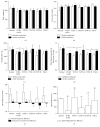The Effect of Tong-Xie-Yao-Fang on Intestinal Mucosal Mast Cells in Postinfectious Irritable Bowel Syndrome Rats
- PMID: 28331524
- PMCID: PMC5346372
- DOI: 10.1155/2017/9086034
The Effect of Tong-Xie-Yao-Fang on Intestinal Mucosal Mast Cells in Postinfectious Irritable Bowel Syndrome Rats
Abstract
Objective. To investigate the effects of Tong-Xie-Yao-Fang (TXYF) on intestinal mucosal mast cells in rats with postinfectious irritable bowel syndrome (PI-IBS). Design. PI-IBS rat models were established using a multistimulation paradigm. Then, rats were treated with TXYF intragastrically at doses of 2.5, 5.0, and 10.0 g·kg-1·d-1 for 14 days, respectively. Intestinal sensitivity was assessed based on abdominal withdrawal reflex (AWR) scores and fecal water content (FWC). Mast cell counts and the immunofluorescence of tryptase and c-Fos in intestinal mucosa were measured; and serum IL-1β, TNF-α, and histamine levels were determined. Results. AWR reactivity and FWC which were significantly increased could be observed in PI-IBS rats. Remarkably increased mast cell activation ratio in intestinal mucosa, together with increased serum TNF-α and histamine levels, could also be seen in PI-IBS rats; furthermore, PI-IBS-induced changes in mast cell activation and level of serum TNF-α and histamine could be reversed by TXYF treatment. Meanwhile, tryptase and c-Fos expression were also downregulated. Conclusion. TXYF improves PI-IBS symptoms by alleviating behavioral hyperalgesia and antidiarrhea, the underlying mechanism of which involves the inhibitory effects of TXYF on activating mucosal mast cells, downregulating tryptase and c-Fos expression, and reducing serum TNF-α and histamine levels.
Conflict of interest statement
The authors declare that they have no competing interests.
Figures






Similar articles
-
Tong-Xie-Yao-Fang improves intestinal permeability in diarrhoea-predominant irritable bowel syndrome rats by inhibiting the NF-κB and notch signalling pathways.BMC Complement Altern Med. 2019 Nov 27;19(1):337. doi: 10.1186/s12906-019-2749-4. BMC Complement Altern Med. 2019. PMID: 31775739 Free PMC article.
-
Tong-Xie-Yao-Fang alleviates diarrhea-predominant irritable bowel syndrome in rats via the GCN2/PERK-eIF2α-ATF4 signaling pathway.Phytomedicine. 2022 Dec;107:154350. doi: 10.1016/j.phymed.2022.154350. Epub 2022 Jul 22. Phytomedicine. 2022. PMID: 36194974
-
Herbal prescription Chang'an II repairs intestinal mucosal barrier in rats with post-inflammation irritable bowel syndrome.Acta Pharmacol Sin. 2015 Jun;36(6):708-15. doi: 10.1038/aps.2014.170. Epub 2015 May 11. Acta Pharmacol Sin. 2015. PMID: 25960135 Free PMC article.
-
Tong Xie Yao Fang: A Classic Chinese Medicine Prescription with Potential for the Treatment of Ulcerative Colitis.Evid Based Complement Alternat Med. 2021 Jun 9;2021:5548764. doi: 10.1155/2021/5548764. eCollection 2021. Evid Based Complement Alternat Med. 2021. PMID: 34211567 Free PMC article. Review.
-
Postinfectious irritable bowel syndrome.J Pediatr Gastroenterol Nutr. 2009 Apr;48 Suppl 2:S95-7. doi: 10.1097/MPG.0b013e3181a15e2e. J Pediatr Gastroenterol Nutr. 2009. PMID: 19300138 Review.
Cited by
-
Paeoniflorin Ameliorates Colonic Fibrosis in Rats with Postinfectious Irritable Bowel Syndrome by Inhibiting the Leptin/LepRb Pathway.Evid Based Complement Alternat Med. 2022 Oct 3;2022:6010858. doi: 10.1155/2022/6010858. eCollection 2022. Evid Based Complement Alternat Med. 2022. PMID: 36225193 Free PMC article.
-
Acupuncture plus Chinese Herbal Medicine for Irritable Bowel Syndrome with Diarrhea: A Systematic Review and Meta-Analysis.Evid Based Complement Alternat Med. 2019 Apr 14;2019:7680963. doi: 10.1155/2019/7680963. eCollection 2019. Evid Based Complement Alternat Med. 2019. PMID: 31110553 Free PMC article. Review.
-
Neuromuscular electrical stimulation as an adjunctive therapy to drotaverine hydrochloride for treating patients with diarrhea-predominant irritable bowel syndrome: A retrospective study.Medicine (Baltimore). 2018 Jul;97(29):e11478. doi: 10.1097/MD.0000000000011478. Medicine (Baltimore). 2018. PMID: 30024524 Free PMC article.
-
Efficacy of Compound Herbal Medicine Tong-Xie-Yao-Fang for Acute Radiation Enteritis and Its Potential Mechanisms: Evidence from Transcriptome Analysis.Biomed Res Int. 2020 Dec 1;2020:5481653. doi: 10.1155/2020/5481653. eCollection 2020. Biomed Res Int. 2020. PMID: 33344641 Free PMC article.
-
Suppression of PTRF Alleviates Post-Infectious Irritable Bowel Syndrome via Downregulation of the TLR4 Pathway in Rats.Front Pharmacol. 2021 Oct 7;12:724410. doi: 10.3389/fphar.2021.724410. eCollection 2021. Front Pharmacol. 2021. PMID: 34690766 Free PMC article.
References
LinkOut - more resources
Full Text Sources
Other Literature Sources
Research Materials
Miscellaneous

